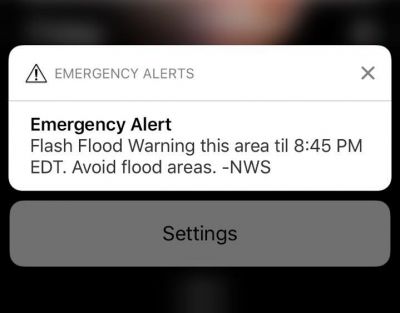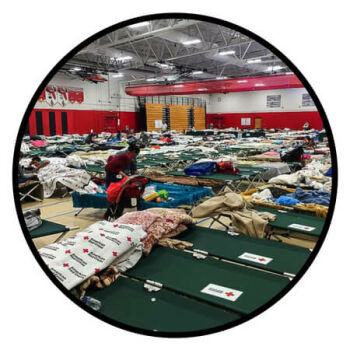It can be tempting to procrastinate this essential task without the pressure of a looming storm or approaching flood, but creating an emergency preparedness plan well in advance will leave you more time to safeguard your home and protect your belongings when a storm does hit. More importantly, taking the time to plan for any contingency can help minimize feelings of panic and help you stay calm when disaster hits.
Every household should have an emergency preparedness plan, whether you live on the coast or miles inland. While coastal areas are at greater risk for flooding during hurricane season, inland regions like the Midwest are still susceptible to floods each spring during the winter thaw, and in the event of heavy rain during summer.
Start by identifying which threats are most likely to impact your area. Once you know what events to anticipate, you can start creating a plan for how you’ll handle each scenario. Ready.gov recommends answering four key questions:
- What is your shelter plan?
- What is your emergency evacuation plan?
- What is your family or household communication plan?
Let’s take a closer look at each of these considerations.
1. How will you receive emergency alerts and warnings?
Before you can plan for how you will receive alerts, it helps to know what alerts are issued and what actions they require. When it comes to weather-related natural disasters, there are two levels of alert:
- Watch: A watch means there is a high possibility that a weather emergency will occur. When a watch is issued, you can stay informed by setting up notifications on your smartphone, listening to the radio or watching the news, and paying attention to any weather changes that may occur. This is also when you should double check to make sure you have everything you need at hand.
- Warning: A warning means that a weather emergency is already happening, or will happen soon, and that you should take immediate action by seeking shelter or preparing to evacuate.
Next, take some time to learn which types of alerts your community uses. If you aren’t already aware, contact your local emergency management office. Alerts are typically issued using one or more of these methods:
1. Wireless Emergency Alerts (WEAs)
Wireless Emergency Alerts look like text messages, but are accompanied by a unique sound and vibration pattern. The alert will include the type and time of alert, any action you should take, and the issuing agency. These alerts can only be sent for three reasons:
- Imminent threats to safety of life, issued in two categories: extreme threat and severe threat
- AMBER alert
- Presidential alerts
WEAs are available through the Integrated Public Alert and Warning System infrastructure, and can only be sent by authorized institutions, including state and local public safety officials, the National Weather Service, the National Center for Missing and Exploited Children, and the President of the United States. You will not be charged for receiving a WEA, and there’s no need to subscribe.
A Wireless Emergency Alert may look something like this:

2. Emergency Alert System
The Emergency Alert System is a national public warning system that requires broadcasters, satellite digital audio services, direct broadcast service providers, cable television systems, and wireless cable systems to provide the President with the ability to address the nation within ten minutes of a national emergency. This system may also be used by state and local authorities to deliver important information about weather and other imminent threats.
3. NOAA Weather Radio
The National Oceanic and Atmospheric Administration (NOAA) Weather Radio is a nationwide network of radio stations that broadcasts continuous weather information from the nearest National Weather Service office. NOAA Weather Radio can also issue non-weather emergency alerts for events like national security threats.
4. Other sources
Your community may also use digital road signs, social media, or sirens and speakers to alert you to any imminent weather-related threats. For more information, visit Ready.gov.
| PRO TIP: Make sure each member of your family is signed up to receive alerts and warnings from the National Weather Service or your local emergency management office. |
2. What is your shelter plan?
Once you know how you will receive emergency alerts, you can start to plan for how you’ll handle the situation when you receive one. Often, your first step will be to take shelter somewhere safe.
You’ve already identified the most common disasters in your area, such as hurricane, wildfire, or tornado. Now, think about where you and your family spend most of your time, such as your home, school, or workplace, so you can identify the safest place at each of these locations to take shelter for each type of natural disaster.
Sheltering at home
If the best place for you to take shelter is in your own home, identify which room is the safest to weather each type of disaster. Depending on the severity and nature of the threat, as well as your location when you receive the alert, the safest place to take shelter could be:
- An interior, windowless room
- A room on upper floors, if flooding is imminent
- Basements or other underground spaces, if in the path of a tornado
Even if floodwaters don’t reach you, you may lose power or water. When you’re making your emergency plan, assume you won’t be able to leave your home for at least three days, and include enough supplies in your disaster kit for each person in your home. Stay inside until officials tell you it’s safe to leave.
Sheltering at work or at school
Your workplace or your kids’ school should have a plan in place for how they’ll handle a natural disaster. Do your research and include any relevant information in your emergency plan. You may also wish to create a streamlined disaster kit you can store at work or in your kids’ backpack to make sure they have everything they need if a storm is coming or you need to evacuate.

Sheltering at an evacuation center
Your best option may be to find shelter outside the disaster area, such as with family or friends, commercial lodging, or at an evacuation shelter. Check the FEMA mobile app to find the shelter nearest you. If the safest place for you to take shelter is an evacuation center, or if you’ve been ordered to evacuate your home, bring your emergency kit with you so you know you’ll have the supplies you require.
Pictured right: Immokalee High School Red Cross Shelter. FEMA/Robert Kaufmann.
Sheltering in place
Sometimes, it may not be safe for you to get home or to your designated meeting place, and your safest option will be to take shelter wherever you are located when disaster hits. This is called “sheltering in place”. If you must shelter in place, follow these guidelines:
- Seal all windows, doors, and air vents with temporary plastic sheeting and duct tape, if available
- Never use a generator, gas-powered equipment of any kind, grill, camp stove, or charcoal burning device indoors
If you are forced to shelter in place in a temporary shelter, move to a sturdy building when it’s safe, and look for a windowless room on the lowest floor that’s not likely to flood. Stay inside until public safety officials say it’s safe to leave.
3. What is your evacuation plan?
In some cases, you may have 1-2 days notice before a mandatory evacuation, while other natural disasters may necessitate immediate departure. Creating a plan for how you’ll handle either situation ensures you are ready to evacuate as quickly as circumstances require.
When you're creating an effective emergency evacuation plan, you should address two main components: where will you go, and how will you get there?
Where will you go?
Start by deciding where you and your family will go in the event of natural disaster, or where you will meet if you are separated. Designate these four spots:
- In your home: What room in your house should everyone head to if a natural disaster hits? This should be a small, ideally interior and windowless room, such as a closet or bathroom, on the lowest level of the building.
| SAFETY TIP: If possible, identify at least two emergency exits for each room in your house. |
- In your neighborhood: If you need to leave your home (in case of fire, for example), choose a place a safe distance away that’s easily accessible for each member of your family, such as a neighbor’s yard.
- Outside your neighborhood: If you aren’t at home and can’t get back, designate a place outside of your neighborhood where you can all meet up, such as a nearby library, community center, a family friend’s house, or with relatives.
- Out of town: If you can’t get home or to any of your other designated meeting spots, or if you aren’t together when you’re instructed to evacuate, choose a central location out of town, ideally on your evacuation route, where you can all meet up. You may wish to choose multiple out-of-town emergency meeting places—one on each side of town—so you can meet at the location that makes the most sense during the disaster at hand.
As a family, decide ahead of time when you should go to each spot in case you can’t get in touch when a disaster strikes. Practice meeting at these places (especially your in-home and neighborhood spots) once a year.
How will you get there?
Once you know where to go and when, you can determine a route to each destination, including safe pathways through your home. Always follow the recommended evacuation route in your area, and don’t take shortcuts—they may be blocked. You should also plan alternative routes in case roads are closed or pathways are blocked, as well as alternative modes of transportation if your car is unavailable or you run out of gas. Be prepared to evacuate on foot if necessary.
Check with your state’s Department of Transportation or Office of Emergency Management to find evacuation routes in your area.
Be ready to evacuate
If you know a natural disaster is on its way, these tips can help ease your evacuation:
- Don’t plan on taking more than one vehicle. This will reduce the likelihood that you and your family will get separated, as well as reduce congestion on the road.
- Store a portable emergency kit in your car at all times.
- If you can, leave early to avoid being trapped by severe weather or traffic congestion.
- Dress appropriately. Wear comfortable, practical clothing, and sturdy shoes.
- Let kids and seniors know who will pick them up in the event of a natural disaster or evacuation.
4. What is your family or household communication plan?
Once you know how you will receive alerts, where you will take shelter, and how you will evacuate, you can focus on how you will communicate with each member of your family when a natural disaster hits.
Start by collecting contact information for each member of your family, as well as important services like medical facilities, family doctors, schools, or other service providers. Your contact list should include:
- Names, phone numbers, and email addresses for each person, including an out-of-town contact person. If you shipped your belongings to a loved one out of the path of the storm, this person is also a good choice for your out-of-town contact person.
- Information on how to communicate with family members who are deaf or hard-of-hearing, have a speech disability, or are visually impaired
- Contact information for medical providers, insurance companies, and other services
Share this list with each member of your family, and make sure everyone has a copy in their briefcase, work bag, or backpack. You may also wish to add phone numbers into everyone’s cell phone—just make sure everyone has a paper copy as well in case their phone runs out of battery and can’t be recharged.
| PRO TIP: Store one number in each person’s phone under the name “In Case of Emergency” or “ICE” to help a stranger identify your emergency contact if necessary. |
Your next step is to designate a leader who will be responsible for sending out information about where to meet. You should also designate an out-of-town contact to act as a central point of contact to help your family reconnect if you get separated—if local phone lines are jammed, it may be easier to get in touch with someone out of town.
How will you keep in touch?
Communications networks like cell towers and internet services may not be functional during a natural disaster or power outage, which is why it’s important to designate an emergency meeting place to head to if you can’t get in touch with your loved ones.
If you are able to reach your family, experts recommend texting over calling. Text messages require less bandwidth than a phone call, and may be more likely to make it through. Make sure everyone in your family knows how to text—including seniors—and discuss beforehand what information you will include in your messages. Focus only on the most vital information to minimize network congestion, free up space for emergency communications, and conserve battery power.
Download family emergency plan templates and read FEMA’s guide for more detailed information on creating a family communication plan.
Get the whole family involved

It’s important to identify and account for the specific needs of each member of your household. Create your family disaster plan together, and discuss each person’s needs and responsibilities, such as:
- Age - households with babies, school-age children, or elderly folks living in the same house will require different considerations than a family of two adults with teenage children.
- Responsibilities for assisting others - who will watch the kids, who will care for your seniors, and who will collect all your emergency supplies if you need to evacuate?
- Dietary needs and restrictions
- Medical needs, such as prescriptions and equipment
- Disabilities or accessibility needs
- Languages spoken
- Pets and service animals
- Cultural and religions considerations
| PRO TIP: If you have kids or seniors to account for, keep your plan as simple and easy to remember as possible. |
Children
- Involve children in the entire process of creating your family disaster plan to help them recall details and alleviate stress
- Teach them to recognize danger signals inside and outside the home, make sure they know what the alerts sound like, and how and when to call for help
- Be aware that discussing and preparing for natural disaster can be frightening for children—reassure them that being prepared helps keep them safe, and consider including special items in your emergency kit to help keep them comfortable, such as toys or a favorite blanket
Seniors
If they live at home:
- Make sure emergency numbers are printed in large print and stored near your primary telephone
- Include appropriate emergency supplies in your disaster kit, such as extra medications
- Talk to your neighbors to create a support network in case you aren’t home when disaster hits
If they live in a nursing home:
- Learn and understand the preparedness measures of their nursing home, as well as how residents will be transported in case of evacuation
- Find out if and when families are notified, and whether they have the option to pick up the resident
Disabilities, or special access or functional needs
- Find out if you need to register with your fire department or emergency management office so help can be provided quickly in the event of an emergency
- Contact their home healthcare agency to find out what their plans are in the event of natural disaster
- Identify accessible sheltering locations in and around your home, and ensure there is more than one accessible exit
- Set up a back-up power supply for essential medical equipment
- Consider plans for service animals and pets
Pets
Pets are not allowed in most shelters and hotels (service animals excepted). When you’re making your emergency plan, you can either:
- If you are evacuating to a place that allows pets, such as a friend or relative’s house, make sure you include the necessary items in your evacuation kit
- Identify a friend or family member out of town who can take care of them till the disaster passes
- Stay at a pet-friendly hotel
- Contact a pet-boarding facility out of the path of the storm.
Final steps
Preparedness doesn’t stop when you’ve finalized your emergency plan. Review and update your family's disaster plan once a year, and schedule an annual practice so everyone in your family knows who to call, where to go, and how to get there.
For detailed information on how to prepare for all types of natural disasters, including family and hurricane emergency plan templates, check out Ready.gov.
